The Cost of Going Green
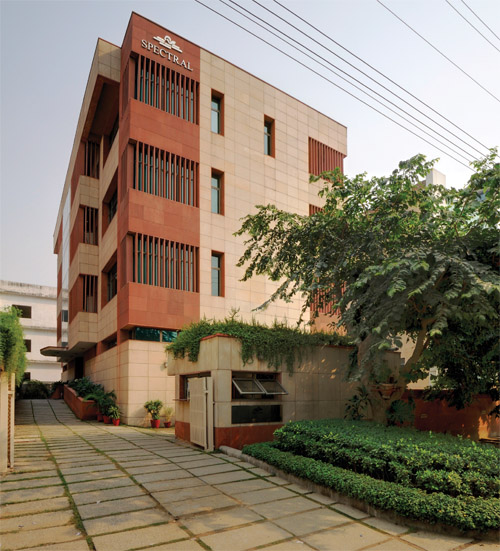 |
| Corporate Head Office of Spectral Services Consultants Pvt. Ltd, NOIDA (Picture Courtesy: ABRD Architects) |
Ar Apurva Bose Dutta
'Green' is the new colour of India and how - from green hotels, green metros, green airports, green hospitals, green pavilions, green libraries to architects, magazines, ebooks, websites all talking green; the concept of green has stepped in confidently to combat issues of energy and global warming. India has a lot of green achievements to its credit. The CII-Sohrabji Godrej Green Business Centre in Hyderabad by architect Karan Grover was the first building outside USA to be awarded the LEED platinum rating. Chennai's Olympia Tech Park is the biggest commercial building in the world to be awarded the LEED gold rating. The ITC Gardenia Hotel in Bengaluru is the world's largest LEED platinum rated green hotel building. The new Tamil Nadu Assembly building is the first Assembly building in the world to be designed and constructed as a green building.
While zero carbon cities are being planned in the world, come 2012 and Ahmedabad and Jaipur will be amongst other metropolis to have a township with over a million people living in a sustainable and environment friendly model urban environment. Whether architects, consultants or developers, everyone has joined the green brigade and the Indian Green Building Council (IGBC) envisages India to be one of the global leaders in green buildings by 2015.
Green has been an intrinsic part of India. With the green revolution that commenced before our births pertaining to self sufficiency in food levels to today's green revolution in construction, the words 'green' and 'sustainability' have been an inherent part of the Indian culture and tradition. Infact, a closer look at the aspects of green buildings such as daylight and natural ventilation and one realizes that they are actually fundamental principles of a good design that have somehow been ignored over time. The green revolution in construction that commenced in 2001 has led to Indian today possessing the second largest green footprint in the world for registered green buildings. Such a progress in such a short while has made India a role model for many countries.
Rather than a development trend, the green approach has today become an effort best suited to the demands of its time. Indian commercial buildings have higher energy performance index than most of its counterparts abroad. Studies show that construction costs for commercial buildings in USA is about eight times that in India, while operating energy costs in USA is 1/4th that in India. Gradually as one sees the ECBC being made a mandate for buildings, green will not be an option but a norm.
Green buildings lead to environmental, economic and social benefits. While improving the quality of the environment by reducing emissions, they lead to reduced stresses, better health, better productivity at work and ensure temperature moderation, storm water management, material efficiency and an aesthetic architecture designed in harmony with its natural surroundings.
The only deterrent that has maybe eclipsed the green architecture in India is the widespread deliberations on the cost factors. Myths and false conceptions have blurred the sanctity of green buildings. A global survey way back in 2007 found that most property professionals overestimate the cost of constructing energy-efficient buildings by upto 300%. Studies in the US over time have revealed that certified green buildings don't cost any more than conventional buildings on a per square foot basis.
 Architect Anupam Bansal, Principal Partner of Delhi based ABRD Architects and SPA design Pvt Ltd (India) has achieved a platinum rating for his Noida Based Spectral Services Corporate office. He admits that the capital cost of green buildings is higher. Depending upon the rating one adopts, it could be as much as 10% higher as the cost of equipment is much higher. But he is quick to add, "The real financial benefit kicks in during the operation cost of the building."
Architect Anupam Bansal, Principal Partner of Delhi based ABRD Architects and SPA design Pvt Ltd (India) has achieved a platinum rating for his Noida Based Spectral Services Corporate office. He admits that the capital cost of green buildings is higher. Depending upon the rating one adopts, it could be as much as 10% higher as the cost of equipment is much higher. But he is quick to add, "The real financial benefit kicks in during the operation cost of the building."
Additional design analysis, computer modelling, product research and lifecycle cost analysis for alternative materials does require an extra investment in the beginning but through reduced maintenance, utilities, longer life of building materials and a better environment, the returns compensate for the initial investments. Infact in the longer run green buildings can prove to be more economical than conventional buildings. Earlier green projects were costlier due to new methods of design and construction but by 2005-2006, the costs were being lowered to more conventional levels. The availability of larger choice of green products in the country today is also moderating the cost factors.
 In its wake to spread green awareness, Bengaluru based L'Avenir Consultancy Private Limited is involved with Green education, training and consulting and also is responsible for a premium quarterly Green magazine called L'Avenir Green Digest. V Jagadish Kumar, a IGBC accredited professional who heads it is a member of the Bengaluru IGBC Core Committee and is also the head of the IGBC student chapter committee for Karnataka. Citing factual data he adds, "The cost premium of building a green building over a normal development was approx 8% in 2008, reducing from 18% premium in 2003. It is expected to further decline to 1-2% premium by 2014-2015."
In its wake to spread green awareness, Bengaluru based L'Avenir Consultancy Private Limited is involved with Green education, training and consulting and also is responsible for a premium quarterly Green magazine called L'Avenir Green Digest. V Jagadish Kumar, a IGBC accredited professional who heads it is a member of the Bengaluru IGBC Core Committee and is also the head of the IGBC student chapter committee for Karnataka. Citing factual data he adds, "The cost premium of building a green building over a normal development was approx 8% in 2008, reducing from 18% premium in 2003. It is expected to further decline to 1-2% premium by 2014-2015."
Data available also validate this fact. While CII-Godrej GBC (built in 2003) - a platinum rated building saw a 18% increase in the cost which it was able to pay back in 7 years; the Spectral Services Consultants Office in Noida built in 2007 with a 8% increase in cost gave a payback in 4 years.
The cost of green buildings depend on various factors-the building program, demographic location, the rating which is being tried to achieve (if at all), how early the green principles have been applied in the project and the competence of the designers with green concepts. Notably, green buildings provide financial benefits that conventional buildings do not; the benefits include energy and water savings, optimal daylight and ventilation (leading to less dependency on mechanical systems), reduced waste, improved indoor environmental quality, reduced operation costs and reduced infrastructure strain. It would be useful to add here that invariably some benefits (like greater employee comfort/productivity, occupants' health) fall in the category of less tangible green building benefits and cannot be quantified; hence they are not considered in cost analysis.
While evaluating costs of green buildings it is important to look beyond the first costs and increasingly architects have been using life-cycle assessments (LCA) to evaluate and quantify the economic and environmental costs and benefits of materials and products over their lives. These life cycle costs which are ensured as a result of increased productivity, higher rents, lower turnover rates, and other real estate benefits will create a much larger return on investment than cost savings from operational costs alone. Ahmedabad based architects Parul Zaveri and Nimish Patel (Abhikram Architects) known for their enigmatic approach to green buildings and sustainability designed the Torrent Research Centre in Ahmedabad in 2000, a project that is hailed as one of the largest successful experiments of passage cooling in Asia. A successful case study for many a green projects, the successful returns can be proven from the fact that from the savings of the electrical costs, the additional expenditure has been recovered in less than one year; the cost of all the buildings will be recovered in 13 years and the entire investment in the research activities will get recovered in 39 years.
 Delhi based Architect Vinod Gupta, heading Space Design Consultants and much known for his green designs and research projects incorporating solar heating and natural cooling in buildings feels that it is important to understand what green buildings are. "Due to the dominance of rating systems, people understand that architects can design an ordinary (poorly conceived) building and then apply green fixes to achieve the targets set by green rating systems. Understandably such 'fixed' buildings do cost more. The alternative is for the architect to design a green building from scratch and actually save money", he maintains.
Delhi based Architect Vinod Gupta, heading Space Design Consultants and much known for his green designs and research projects incorporating solar heating and natural cooling in buildings feels that it is important to understand what green buildings are. "Due to the dominance of rating systems, people understand that architects can design an ordinary (poorly conceived) building and then apply green fixes to achieve the targets set by green rating systems. Understandably such 'fixed' buildings do cost more. The alternative is for the architect to design a green building from scratch and actually save money", he maintains.
The IGBC website admitting to a slightly higher cost of a green building than a conventional building points out that one needs to have a baseline cost for all comparisons to be alike. The incremental cost is always relative and depends on the extent of eco-friendly features already considered during design. The website also mentions that the incremental cost has to be looked in relation to the life cycle cost. The website says, "This kind of an approach could be revealing since over its life cycle, the operating cost would work out to 80%-85 % of the capital cost while the incremental cost which is a one-time cost is only about 8%-10%."
Studies conducted in India analyzing the financial costs and benefits of green buildings have concluded that 'a minimal increase in upfront investment of about 2%-12% of construction costs to support green design, typically yields life cycle savings of over 20% of total construction costs- over ten times the initial upfront investment'.
To mitigate project costs, one should understand that cost savings can be fully realized only when the green principles are implemented at the conceptual stage of the project where the building needs to be designed as one system. Also, working with green consultants with specific green requirements and identification of goals right from the outset proves beneficial.
Architect Bansal feels that the cost issues need to be addressed by the various equipment manufacturers and adds, "I can't say how the cost of HVAC, electrical or plumbing devices can be brought down as the concerned industry leaders should address this. However, I can say that as common sense, designers should provide good daylight to all parts of the buildings, orient buildings correctly and provide cross ventilation in non AC spaces. One can even adopt means like biological treatment of solid waste instead of mechanical sewage treatment plants which cost more to install and operate."
Design cost factors can be mitigated by calculating a realistic anticipated load, standardizing equipment locations, envisaging the expansion and planning accordingly. Construction cost factors can be minimized by clearing out specifications about new construction materials and if the project is applying for a LEED rating. Every green building necessarily needn't apply for a LEED or a GRIHA rating in which case it might be better to use the rating systems as mere guidelines and not go in for the certification process.
Architect Gupta feels that it will be easy for users to accept and actually demand green buildings once they understand that green can mean better performance and lower costs.
Mr Jagadish adds that the cost of green can be brought down by encouraging green building products in all aspects ranging from sustainable sites, water and energy efficiency, materials/resources and indoor environmental quality.
Energy efficient products like Innovative lighting controls, photovoltaic solar electricity, Solar resistant glass, Energy recovery ventilators, Energy Efficient air conditioners, Solar Roofing membranes, Lightpipe Daylighting (capturing the sunlight from rooftops and piping it down through reflective tubing) exist. For water efficiency one needs to consider smart irrigation controls that save water by only applying it when the soil is dry. Low-flow showerheads and sinks, sensor taps, water-free urinals and dual flush toilets are also preferred faucets.
Other green innovations include horizontally perforated clay hollow blocks (which besides giving excellent sound and thermal insulation save on structural costs); Autoclaved aerated concrete blocks, Wall Form system (a construction system comprising of lightweight panels), Cellular Lightweight concrete (which reduces consumption of reinforcing and cement and saves energy); Heat resistant terrace tiles (replicating the benefits of conventional cool roofing); Thermal insulation boards; Porous pavement system and Sky ceilings.
There exist engineered wood products for decking, sheathing and framing lumber that use far fewer materials than conventional products, or use materials that would formerly have been considered waste. Polished concrete floors reduce the need for finished floors in a building. A number of silicone based adhesives and sealants have been devised for sustainable designs and are being used in India.
Green materials also include fly ash cement, fly ash blocks, recycled aluminium, recycled steel, recycled tiles, low VOC paints and bamboo-based products. Water reclamation systems, solar shading devices, green roofs gardens, green walls, heat reflective paints, eco-friendly cabling, Pressure Reducing Valves, HFC-based high efficiency chillers and structural concrete insulated panels are also becoming famous. Smart Home control systems help to go green.
Green building incentives throughout the world include tax incentives like property tax abatement for LEED Silver or higher ratings, sales tax relief for solar units; increased FAR, priority processing of building permits, density bonuses for LEED projects, utility subsidies for photovoltaic systems and grants and loans for renewable energy systems. In US and UK such buildings have good technical and financial support from the public administrations at national, state and local levels. The American Recovery and Reinvestment Act puts US$ 250 million into a Green Retrofit Program for Multifamily Housing, providing loans and grants for energy and green retrofits in the multifamily assisted housing stock. Canada offers the ecoENERGY Retrofit Incentive for Buildings, which provides financial incentives for retrofitting existing buildings to make them more energy efficient.
For India Architect Bansal recommends incentives like subsidies or loans at lower interest rates for installing equipment such as solar panels, efficient chillers etc; lower power/water/gas tariffs for Green Rated buildings and the sponsorship of 50% of Green Certification fees (GRIHA/ USGBC/ IGBC fees for awarding green certification).
In India though incentives are being given and planned, one notices that the major policy decisions by the Indian government are a result of their responses to international events like Earth Summits etc. At the state level however there are incentives as noticed in Mumbai, Andhra Pradesh and Hyderabad. Recently, a news clipping showed that the Cabinet of Delhi and the Pimpri Chinchwad Municipal Corporation in Maharashtra passed resolutions calling for all future buildings to be GRIHA compliant. Also, the Ministry of Environment and Forests (MoEF) has announced that GRIHA-certified projects will receive a preferred Environmental Impact Assessment (EIA) which is a mandatory requirement of all building projects more than 20,000sqm. A preferential EIA helps to speed up applications for building permits, etc. and confers a marked advantage upon businesses in the sector. The Government of Andhra Pradesh has announced a rebate of 10% in property tax on use of solar heating and lighting system, on recycling of waste water and rain harvesting. The Hyderabad Metropolitan Development Authority has introduced a number of national incentives (like institution of awards, capital subsidy for SPV installations) and local incentives.
The government's decision of leading by example by having all new central government and PSU buildings to meet requirements of at least three star rating under GRIHA is also encouraging.The endorsement of GRIHA by the government has induced a number of leading developers and construction firms to apply GRIHA's guidelines. A member of the Technical Advisory Committee for GRIHA, Architect Gupta says, "The government has accepted GRIHA as the national green building rating system. This system also stops at 30% reduction in resource use as the ultimate goal. A better policy would be to allow an open ended rating system that recognizes and rates consumption and not notional savings that don't really exist."
Mr Jagadish feels that the government needs to set up a policy framework that brings the philosophy of sustainability to the mainstream, making it more a necessity rather than an option. He concludes, "A concerted and coordinated effort by the various ministries of the government to promote the concept of sustainability through policy formulation, facilitation of certain key subsectors in the Indian market, establishment of monitoring and verification frameworks for energy efficiency measurement, along with incentive schemes for adoption of green concepts by private establishments are the need of the hour."
Ar. Apurva Bose Dutta is a Bengaluru based Architectural Journalist
'Green' is the new colour of India and how - from green hotels, green metros, green airports, green hospitals, green pavilions, green libraries to architects, magazines, ebooks, websites all talking green; the concept of green has stepped in confidently to combat issues of energy and global warming. India has a lot of green achievements to its credit. The CII-Sohrabji Godrej Green Business Centre in Hyderabad by architect Karan Grover was the first building outside USA to be awarded the LEED platinum rating. Chennai's Olympia Tech Park is the biggest commercial building in the world to be awarded the LEED gold rating. The ITC Gardenia Hotel in Bengaluru is the world's largest LEED platinum rated green hotel building. The new Tamil Nadu Assembly building is the first Assembly building in the world to be designed and constructed as a green building.
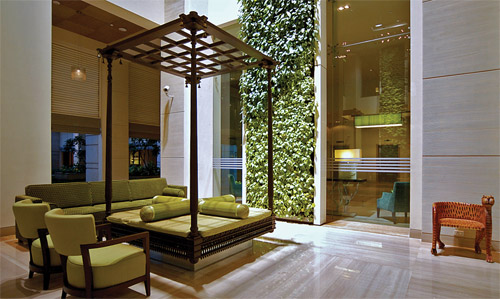 |
| Lobby at ITC Gardenia, Bengaluru (Picture Courtesy: ITC Gardenia) |
While zero carbon cities are being planned in the world, come 2012 and Ahmedabad and Jaipur will be amongst other metropolis to have a township with over a million people living in a sustainable and environment friendly model urban environment. Whether architects, consultants or developers, everyone has joined the green brigade and the Indian Green Building Council (IGBC) envisages India to be one of the global leaders in green buildings by 2015.
Green has been an intrinsic part of India. With the green revolution that commenced before our births pertaining to self sufficiency in food levels to today's green revolution in construction, the words 'green' and 'sustainability' have been an inherent part of the Indian culture and tradition. Infact, a closer look at the aspects of green buildings such as daylight and natural ventilation and one realizes that they are actually fundamental principles of a good design that have somehow been ignored over time. The green revolution in construction that commenced in 2001 has led to Indian today possessing the second largest green footprint in the world for registered green buildings. Such a progress in such a short while has made India a role model for many countries.
Rather than a development trend, the green approach has today become an effort best suited to the demands of its time. Indian commercial buildings have higher energy performance index than most of its counterparts abroad. Studies show that construction costs for commercial buildings in USA is about eight times that in India, while operating energy costs in USA is 1/4th that in India. Gradually as one sees the ECBC being made a mandate for buildings, green will not be an option but a norm.
Green buildings lead to environmental, economic and social benefits. While improving the quality of the environment by reducing emissions, they lead to reduced stresses, better health, better productivity at work and ensure temperature moderation, storm water management, material efficiency and an aesthetic architecture designed in harmony with its natural surroundings.
The Whole Debate about the Cost of Green Projects
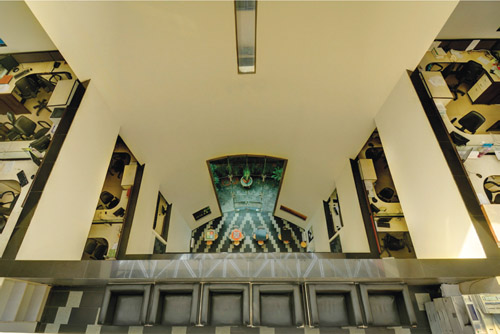 |
| Corporate Head Office of Spectral Services Consultants Pvt. Ltd, NOIDA (Picture Courtesy: ABRD Architects) |
The only deterrent that has maybe eclipsed the green architecture in India is the widespread deliberations on the cost factors. Myths and false conceptions have blurred the sanctity of green buildings. A global survey way back in 2007 found that most property professionals overestimate the cost of constructing energy-efficient buildings by upto 300%. Studies in the US over time have revealed that certified green buildings don't cost any more than conventional buildings on a per square foot basis.

Additional design analysis, computer modelling, product research and lifecycle cost analysis for alternative materials does require an extra investment in the beginning but through reduced maintenance, utilities, longer life of building materials and a better environment, the returns compensate for the initial investments. Infact in the longer run green buildings can prove to be more economical than conventional buildings. Earlier green projects were costlier due to new methods of design and construction but by 2005-2006, the costs were being lowered to more conventional levels. The availability of larger choice of green products in the country today is also moderating the cost factors.
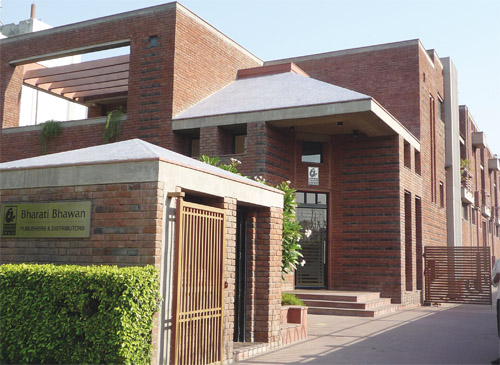 |
| Bharati Bhawan office building, Noida (Picture Courtesy: Space Design Consultants) |

Data available also validate this fact. While CII-Godrej GBC (built in 2003) - a platinum rated building saw a 18% increase in the cost which it was able to pay back in 7 years; the Spectral Services Consultants Office in Noida built in 2007 with a 8% increase in cost gave a payback in 4 years.
The cost of green buildings depend on various factors-the building program, demographic location, the rating which is being tried to achieve (if at all), how early the green principles have been applied in the project and the competence of the designers with green concepts. Notably, green buildings provide financial benefits that conventional buildings do not; the benefits include energy and water savings, optimal daylight and ventilation (leading to less dependency on mechanical systems), reduced waste, improved indoor environmental quality, reduced operation costs and reduced infrastructure strain. It would be useful to add here that invariably some benefits (like greater employee comfort/productivity, occupants' health) fall in the category of less tangible green building benefits and cannot be quantified; hence they are not considered in cost analysis.
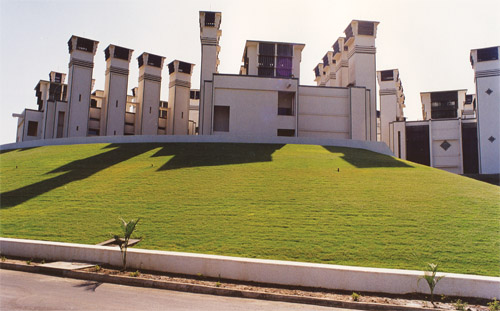 |
| Torrent Research Centre, Ahmedabad (Picture Courtesy: Abhikram Architects) |
While evaluating costs of green buildings it is important to look beyond the first costs and increasingly architects have been using life-cycle assessments (LCA) to evaluate and quantify the economic and environmental costs and benefits of materials and products over their lives. These life cycle costs which are ensured as a result of increased productivity, higher rents, lower turnover rates, and other real estate benefits will create a much larger return on investment than cost savings from operational costs alone. Ahmedabad based architects Parul Zaveri and Nimish Patel (Abhikram Architects) known for their enigmatic approach to green buildings and sustainability designed the Torrent Research Centre in Ahmedabad in 2000, a project that is hailed as one of the largest successful experiments of passage cooling in Asia. A successful case study for many a green projects, the successful returns can be proven from the fact that from the savings of the electrical costs, the additional expenditure has been recovered in less than one year; the cost of all the buildings will be recovered in 13 years and the entire investment in the research activities will get recovered in 39 years.

The IGBC website admitting to a slightly higher cost of a green building than a conventional building points out that one needs to have a baseline cost for all comparisons to be alike. The incremental cost is always relative and depends on the extent of eco-friendly features already considered during design. The website also mentions that the incremental cost has to be looked in relation to the life cycle cost. The website says, "This kind of an approach could be revealing since over its life cycle, the operating cost would work out to 80%-85 % of the capital cost while the incremental cost which is a one-time cost is only about 8%-10%."
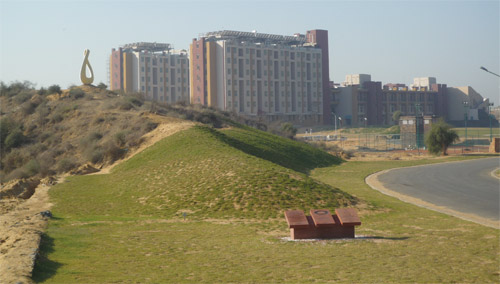 |
| NIIT University, Neemrana, Rajasthan (Picture Courtesy: Space Design Consultants) |
Studies conducted in India analyzing the financial costs and benefits of green buildings have concluded that 'a minimal increase in upfront investment of about 2%-12% of construction costs to support green design, typically yields life cycle savings of over 20% of total construction costs- over ten times the initial upfront investment'.
Ways to Mitigate the Cost
Mr Jagadish who through L'Avenir Green Vision 2020 will provide Free Green Education to 1,00,000 students adds that with regards to cost factors, the ultimate vision is to lessen the costs of construction, operation and maintenance of a Green building so that it can be made cheaper than a conventional building.To mitigate project costs, one should understand that cost savings can be fully realized only when the green principles are implemented at the conceptual stage of the project where the building needs to be designed as one system. Also, working with green consultants with specific green requirements and identification of goals right from the outset proves beneficial.
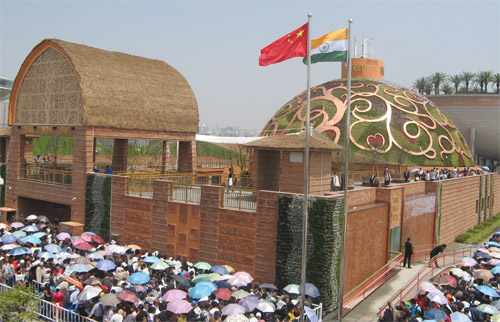 |
| The ‘Green’ Indian Pavillion at the 2010 World Expo at Shanghai with its green dome was a huge success (Picture Courtesy: Arindam Choudhary; Architect Mohan Rao) |
Architect Bansal feels that the cost issues need to be addressed by the various equipment manufacturers and adds, "I can't say how the cost of HVAC, electrical or plumbing devices can be brought down as the concerned industry leaders should address this. However, I can say that as common sense, designers should provide good daylight to all parts of the buildings, orient buildings correctly and provide cross ventilation in non AC spaces. One can even adopt means like biological treatment of solid waste instead of mechanical sewage treatment plants which cost more to install and operate."
Design cost factors can be mitigated by calculating a realistic anticipated load, standardizing equipment locations, envisaging the expansion and planning accordingly. Construction cost factors can be minimized by clearing out specifications about new construction materials and if the project is applying for a LEED rating. Every green building necessarily needn't apply for a LEED or a GRIHA rating in which case it might be better to use the rating systems as mere guidelines and not go in for the certification process.
Architect Gupta feels that it will be easy for users to accept and actually demand green buildings once they understand that green can mean better performance and lower costs.
Green Products and Technology
A green building needs to use building materials that will reduce energy consumption, that are non-toxic, reusable, durable, affordable and can minimise waste in manufacture and use.Mr Jagadish adds that the cost of green can be brought down by encouraging green building products in all aspects ranging from sustainable sites, water and energy efficiency, materials/resources and indoor environmental quality.
Energy efficient products like Innovative lighting controls, photovoltaic solar electricity, Solar resistant glass, Energy recovery ventilators, Energy Efficient air conditioners, Solar Roofing membranes, Lightpipe Daylighting (capturing the sunlight from rooftops and piping it down through reflective tubing) exist. For water efficiency one needs to consider smart irrigation controls that save water by only applying it when the soil is dry. Low-flow showerheads and sinks, sensor taps, water-free urinals and dual flush toilets are also preferred faucets.
Other green innovations include horizontally perforated clay hollow blocks (which besides giving excellent sound and thermal insulation save on structural costs); Autoclaved aerated concrete blocks, Wall Form system (a construction system comprising of lightweight panels), Cellular Lightweight concrete (which reduces consumption of reinforcing and cement and saves energy); Heat resistant terrace tiles (replicating the benefits of conventional cool roofing); Thermal insulation boards; Porous pavement system and Sky ceilings.
There exist engineered wood products for decking, sheathing and framing lumber that use far fewer materials than conventional products, or use materials that would formerly have been considered waste. Polished concrete floors reduce the need for finished floors in a building. A number of silicone based adhesives and sealants have been devised for sustainable designs and are being used in India.
Green materials also include fly ash cement, fly ash blocks, recycled aluminium, recycled steel, recycled tiles, low VOC paints and bamboo-based products. Water reclamation systems, solar shading devices, green roofs gardens, green walls, heat reflective paints, eco-friendly cabling, Pressure Reducing Valves, HFC-based high efficiency chillers and structural concrete insulated panels are also becoming famous. Smart Home control systems help to go green.
Incentives and Policies
Besides the hurdle of increase in perceived cost, it is also the lack of knowledge of how to build green that is hitting at green architecture in India today following which it is important for the Government to step in and promote green architecture. In the past through the Energy Conservation Act (ECA 2001), the Indian government has taken a step forward to promote energy efficiency. Non-profit organisation like IGBC, The Energy and Resources Institute (TERI) have contributed a lot in making the 'green concept' heard in India.Green building incentives throughout the world include tax incentives like property tax abatement for LEED Silver or higher ratings, sales tax relief for solar units; increased FAR, priority processing of building permits, density bonuses for LEED projects, utility subsidies for photovoltaic systems and grants and loans for renewable energy systems. In US and UK such buildings have good technical and financial support from the public administrations at national, state and local levels. The American Recovery and Reinvestment Act puts US$ 250 million into a Green Retrofit Program for Multifamily Housing, providing loans and grants for energy and green retrofits in the multifamily assisted housing stock. Canada offers the ecoENERGY Retrofit Incentive for Buildings, which provides financial incentives for retrofitting existing buildings to make them more energy efficient.
For India Architect Bansal recommends incentives like subsidies or loans at lower interest rates for installing equipment such as solar panels, efficient chillers etc; lower power/water/gas tariffs for Green Rated buildings and the sponsorship of 50% of Green Certification fees (GRIHA/ USGBC/ IGBC fees for awarding green certification).
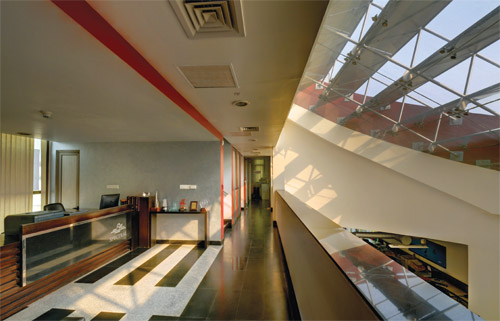 |
| Corporate Head Office of Spectral Services Consultants Pvt. Ltd, NOIDA (Picture Courtesy: ABRD Architects) |
In India though incentives are being given and planned, one notices that the major policy decisions by the Indian government are a result of their responses to international events like Earth Summits etc. At the state level however there are incentives as noticed in Mumbai, Andhra Pradesh and Hyderabad. Recently, a news clipping showed that the Cabinet of Delhi and the Pimpri Chinchwad Municipal Corporation in Maharashtra passed resolutions calling for all future buildings to be GRIHA compliant. Also, the Ministry of Environment and Forests (MoEF) has announced that GRIHA-certified projects will receive a preferred Environmental Impact Assessment (EIA) which is a mandatory requirement of all building projects more than 20,000sqm. A preferential EIA helps to speed up applications for building permits, etc. and confers a marked advantage upon businesses in the sector. The Government of Andhra Pradesh has announced a rebate of 10% in property tax on use of solar heating and lighting system, on recycling of waste water and rain harvesting. The Hyderabad Metropolitan Development Authority has introduced a number of national incentives (like institution of awards, capital subsidy for SPV installations) and local incentives.
The government's decision of leading by example by having all new central government and PSU buildings to meet requirements of at least three star rating under GRIHA is also encouraging.The endorsement of GRIHA by the government has induced a number of leading developers and construction firms to apply GRIHA's guidelines. A member of the Technical Advisory Committee for GRIHA, Architect Gupta says, "The government has accepted GRIHA as the national green building rating system. This system also stops at 30% reduction in resource use as the ultimate goal. A better policy would be to allow an open ended rating system that recognizes and rates consumption and not notional savings that don't really exist."
Mr Jagadish feels that the government needs to set up a policy framework that brings the philosophy of sustainability to the mainstream, making it more a necessity rather than an option. He concludes, "A concerted and coordinated effort by the various ministries of the government to promote the concept of sustainability through policy formulation, facilitation of certain key subsectors in the Indian market, establishment of monitoring and verification frameworks for energy efficiency measurement, along with incentive schemes for adoption of green concepts by private establishments are the need of the hour."
Ar. Apurva Bose Dutta is a Bengaluru based Architectural Journalist
MGS Architecture September-October 2011


















